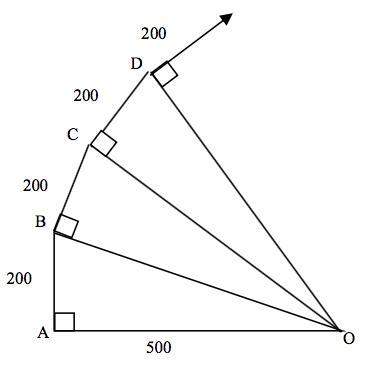Can i have ? there is a diagram attached.
an explorer on the moon moves outward from his spa...

Mathematics, 07.11.2019 11:31 kenariachrista
Can i have ? there is a diagram attached.
an explorer on the moon moves outward from his spaceship (point o) for a distance of 500 metres to a. he then makes a 90° turn and travels 200 metres.
he turns so that his new direction is perpendicular to the line between himself and the spaceship and moves another 200 metres (point b). he is gradually getting further away from his starting point o.
he continues this process until he’s 700m from the spaceship then returns directly to it. (the diagram only shows the first 4 sections of his trip.)
a) calculate how far he is from o when he makes each turn (ie. at a, b, c, etc).
b) if he comes straight home when he is 700m away, what is the total distance he travels?
c) what is the angle between the line oa and ob?
d) what is the angle formed by his departure path and his return path?


Answers: 1
Another question on Mathematics

Mathematics, 21.06.2019 12:30
Without graphing the linear functions, find the coordinates of the point of intersection of their graphs: y=3x−11 and y=4
Answers: 1

Mathematics, 21.06.2019 18:20
Alana has 12.5 cups of flour with which she is baking four loaves of raisin bread and one large pretzel. the pretzel requires 2.5 cups of flour to make. how much flour is in each loaf of raisin bread? explain the steps to follow to get the answer.
Answers: 3

Mathematics, 21.06.2019 20:00
Given the two similar triangles, how do i find the missing length? if a=4, b=5, and b'=7.5 find a'
Answers: 1

Mathematics, 21.06.2019 20:30
Answer asap ill give ! ’ a sample of radioactive material decays over time. the number of grams, y , of the material remaining x days after the sample is discovered is given by the equation y = 10(0.5)^x. what does the number 10 represents in the equation? a. the half-life of the radioactive material, in days b. the amount of the sample, in grams, that decays each day c. the time, in days, it will take for the samples to decay completely d. the size of the sample, in grams, at the time the material was discovered
Answers: 1
You know the right answer?
Questions




Mathematics, 02.09.2021 14:40



History, 02.09.2021 14:40

Physics, 02.09.2021 14:40


English, 02.09.2021 14:40


Chemistry, 02.09.2021 14:40

Social Studies, 02.09.2021 14:40

Mathematics, 02.09.2021 14:40


Chemistry, 02.09.2021 14:40


Biology, 02.09.2021 14:40




